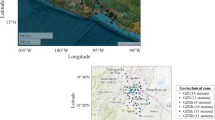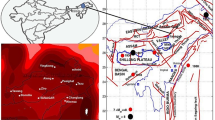Abstract
For the generation of synthetic accelerograms, spectrum compatibility is usually emphasized. However, it is well known that the correct evaluation of the seismic response depends on suitable seismic inputs. For example, Arias Intensity, that measures the energy of an earthquake and which attracts more and more attention in probabilistic seismic analysis, cannot be ignored. Thus, simplified methods which could generate both spectrum-compatible and energy-compatible accelerograms are required. This study focuses on the correction of Arias Intensity when generating artificial synthetic accelerograms for given specific earthquake records. Two simple and efficient approaches are proposed. The first approach introduces an energy-compatible algorithm to the spectrum-compatible model, which enables the generated accelerograms to match both the target response spectrum in the frequency domain and Arias Intensity in the time domain. The second approach refers to an empirical way in which empirical envelope shape functions are directly defined based on the energy distribution profile of given earthquake records. The two approaches are validated using various earthquake records, their performance is proven satisfactory and their application is straightforward in the relative fields of earthquake engineering.













Similar content being viewed by others
Notes
The amplitudes \(A_{i}\) are related to the Power Spectral Density Function (PSDF) as: \(G(\omega _{i})\Delta \omega =A_{i} ^2 /2\). \(G(\omega _{i})\Delta \omega\) represents the contribution of the sinusoid with frequency \(\omega _{i}\) to the total power of the motion.
References
Arias A (1970) A measure of earthquake intensity. In: Hansen R (ed) Seismic design for nuclear power plants. MIT Press, Cambridge, pp 438–483
Boore DM (2001) Effect of baseline corrections on displacements and response spectra for several recordings of the 1999 Chi-Chi, Taiwan, earthquake. Bull Seismol Soc Am 91(5):1199–1211. doi:10.1785/0120000703
Cabañas L, Benito B, Herráiz M (1997) An approach to the measurement of the potential structural damage of earthquake ground motions. Earthq Eng Struct Dyn 26(1):79–92. doi:10.1002/(SICI)1096-9845(199701)26:1<79::AID-EQE624>3.0.CO;2-Y
Cacciola P, Colajanni P, Muscolino G (2004) Combination of modal responses consistent with seismic input representation. J Struct Eng 130(1):47. doi:10.1061/(ASCE)0733-9445(2004)130:1(47)
Del Gaudio V, Pierri P, Wasowski J (2003) An approach to time-probabilistic evaluation of seismically induced landslide hazard. Bull Seismol Soc Am 93(2):557–569
Egan J, Rosidi D (1991) Assessment of earthquake-induced liquefaction using ground-motion energy characteristics. In: Proceedings of the pacific conference on earthquake engineering, Auckland, New Zealand
Gasparini DA,Vanmarcke EH (1976) Simulated earthquake motions compatible with prescribed response spectra. Research Report R76-4. Department of Civil Engineering, Massachusetts Institute of Technology, Cambridge, MA
Greco R, Fiore A, Marano GC (2014) The role of modulation function in nonstationary stochastic earthquake model. J Earthq Tsunami 8(5):1450015
Harp EL, Wilson RC (1995) Shaking intensity thresholds for rock falls and slides: evidence from 1987 Whittier Narrows and superstition hills earthquake strong-motion records. Bull Seismol Soc Am 85(6):1739–1757
Hou S (1968) Earthquake simulation models and their applications. Tech. rep., Massachusetts Institute of Technology, Department of civil engineering
Iyengar RN, Rao P (1979) Generation of spectrum compatible accelerograms. Earthq Eng Struct Dyn 7(3):253–263. doi:10.1002/eqe.4290070305
Jennings PC, Housner GW, Tsai NC (1968) Simulated earthquake motions. Tech. rep., EERL California Institute of Technology
Kaul MK (1978) Stochastic characterization of earthquakes through their response spectrum. Earthq Eng Struct Dyn 6(5):497–509. doi:10.1002/eqe.4290060506
Kayen RE, Mitchell JK (1997) Assessment of liquefaction potential during earthquakes by Arias intensity. J Geotech Geoenviron Eng 123(12):1162–1174. doi:10.1061/(ASCE)1090-0241(1997)123:12(1162)
Kramer SL, Mitchell RA (2006) Ground motion intensity measures for liquefaction hazard evaluation. Earthq Spectra 22(2):413–438. doi:10.1193/1.2194970
Kwon OS, Elnashai A (2006) The effect of material and ground motion uncertainty on the seismic vulnerability curves of RC structure. Eng Struct 28(2):289–303. doi:10.1016/j.engstruct.2005.07.010
Liu SC (1969) Autocorrelation and power spectral density functions of the parkfield earthquake of june 27, 1966. Bull Seismol Soc Am 59(4):1475–1493
Marano GC, Morga M, Sgobba S (2013) Parameters identification of stochastic nonstationary process used in earthquake modelling. Int J Geosci 4(2):290–301
Masi A (2003) Seismic vulnerability assessment of gravity load designed R/C frames. Bull Earthq Eng 1(3):371–395. doi:10.1023/B:BEEE.0000021426.31223.60
Masi A, Vona M, Mucciarelli M (2011) Selection of natural and synthetic accelerograms for seismic vulnerability studies on reinforced concrete frames. J Struct Eng 137(3):367–378. doi:10.1061/(ASCE)ST.1943-541X.0000209
Naeim F, Lew M (1995) On the use of design spectrum compatible time histories. Earthq Spectra 11(1):111–127. doi:10.1193/1.1585805
Nanos N, Elenas A (2006) Seismic duration effects on the vulnerability of buildings. In: First European conference on earthquake engineering and seismology
Rezaeian S (2010) Stochastic modeling and simulation of ground motions for performance-based earthquake engineering. Thesis, University of California, Berkeley
Rezaeian S, Der Kiureghian A (2010) Simulation of synthetic ground motions for specified earthquake and site characteristics. Earthq Eng Struct Dyn 39(10):1155–1180. doi:10.1002/eqe.997
Rezaeian S, Kiureghian AD (2008) A stochastic ground motion model with separable temporal and spectral nonstationarities. Earthq Eng Struct Dyn 37:1565–1584. doi:10.1002/eqe.831
Saragoni GR, Hart GC (1974) Simulation of artificial earthquakes. Earthq Eng Struct Dyn 2(3):249–267. doi:10.1002/eqe.4290020305
Seismosoft (2016) SeismoArtif. http://www.seismosoft.com
Sheng T, Shi W, Xie Y (2012) A modification method of earthquake ground motions for matching multi-dimensional energy input spectra and peak velocity. J Tongji Univ 40(6):807–812. doi:10.3969/j.issn.0253-374x.2012.06.001
Spanos P, Giaralis A, Politis N (2007) Time-frequency representation of earthquake accelerograms and inelastic structural response records using the adaptive chirplet decomposition and empirical mode decomposition. Soil Dyn Earthq Eng 27(7):675–689. doi:10.1016/j.soildyn.2006.11.007
Stafford PJ, Berrill JB, Pettinga JR (2009a) New predictive equations for Arias0 intensity from crustal earthquakes in New Zealand. J Seismol 13(1):31–52. doi:10.1007/s10950-008-9114-2
Stafford PJ, Sgobba S, Marano GC (2009) An energy-based envelope function for the stochastic simulation of earthquake accelerograms. Soil Dyn Earthq Eng 29(7):1123–1133. doi:10.1016/j.soildyn.2009.01.003
Travasarou T, Bray JD, Abrahamson NA (2003) Empirical attenuation relationship for Arias Intensity. Earthq Eng Struct Dyn 32(7):1133–1155. doi:10.1002/eqe.270
Villaverde R (2009) Fundamental concepts of earthquake engineering. CRC Press, Boca Raton
Wang J, Fan L, Qian S, Zhou J (2002) Simulations of non-stationary frequency content and its importance to seismic assessment of structures. Earthq Eng Struct Dyn 31(4):993–1005. doi:10.1002/eqe.134
Yazdani A, Takada T (2009) Wavelet-based generation of energy- and spectrum-compatible earthquake time histories. Comput Aided Civil Infrastruct Eng 24(8):623–630. doi:10.1111/j.1467-8667.2009.00621.x
Yeh CH, Wen YK (1990) Modeling of nonstationary ground motion and analysis of inelastic structural response. Struct Saf 8(1):281–298. doi:10.1016/0167-4730(90)90046-R
Zentner I, Poirion F (2012) Enrichment of seismic ground motion databases using Karhunen–Loève expansion. Earthq Eng Struct Dyn 41(14):1945–1957. doi:10.1002/eqe.2166
Zentner I, Humbert N, Ravet S, Viallet E (2011) Numerical methods for seismic fragility analysis of structures and components in nuclear industry—application to a reactor coolant system. Georisk 5(2):99–109. doi:10.1080/17499511003630512
Zentner I, Allain F, Humbert N, Caudron M (2014) Generation of spectrum compatible ground motion and its use in regulatory and performance-based seismic analysis. In: Cunha A, Caetano E, Ribeiro P, Müller G (eds) Proceedings of the 9th international conference on structural dynamics, EURODYN2014. Porto, Portugal, pp 381–386
Acknowledgements
The grant from Safety Assessment of Concrete Box-girder Arch Bridges (NO. of contract: 2014 318 223 030) supported by Research Institute of Highway Ministry of Transport of China (RIOH) is greatly acknowledged. The authors would also like to acknowledge the SINAPS@ project (Sésisme et Installation Nucléaire: Améliorer et Pérenniser la Sureté), approved and funded by the National Agency of Research (ANR) following the RSNR 2012 call for the projects on future investments post-Fukushima (SINAPS@ ANR-11-RSNR-0022). The help from Mr. Jing LIU from bridge engineering center of RIOH is appreciated.
Author information
Authors and Affiliations
Corresponding author
Appendices
Appendix 1: Commonly used envelope functions
1.1 Exponential envelope shape, Liu (1969)
The envelope shape proposed by Liu (1969) (with selected parameters \(\alpha = 0.2\) and \(\beta = 0.6\)) is shown in Fig. 14.
Envelope shape proposed by Liu (1969). \(\alpha = 0.2\) and \(\beta = 0.6\)
1.2 Piece-wise envelope shape Jennings et al. (1968)
In 1986, Jennings et al. (1968) propose a piece-wise envelope shape as, Eq. (11).
where, \(T_{1}\) and \(T_{2}\) denote the start and end times of an earthquake motion; \(\alpha\) is the model parameter and \(t_{d}\) is the total duration of an earthquake. The envelope shape with selected parameters (\(T_{1}=3.0\), \(T_{2}=8.0\) and \(\alpha =0.2\)) is shown in Fig. 15.
Envelope shape proposed by Jennings et al. (1968). \(T_{1}=3.0\), \(T_{2}=8.0\) and \(\alpha =0.2\)
1.3 Gamma envelope shape proposed by Saragoni and Hart (1974)
Saragoni and Hart (1974) proposed a ‘gamma’ function to simulate the temporal nonstationary. The ‘gamma’ function is proportional to the gamma probability density which is the reason for the name. The ‘gamma’ function reads:
The ‘gamma’ has its maximum equals to \(\alpha _{1}\mathrm {e}^{1-\alpha _{2}}[(\alpha _{2}-1)/\alpha _{3}]^{\alpha _{2}-1}\), when t is \((\alpha _{2}-1)/\alpha _{3}\). The ‘gamma’ envelope shape with selected parameters (\(\alpha _{1}=0.4618\), \(\alpha _{2}=3.0\) and \(\alpha _{3}=0.5\)) is shown in Fig. 16.
Gamma envelope shape proposed by Saragoni and Hart (1974). \(\alpha _{1}=0.4618\), \(\alpha _{2}=3.0\) and \(\alpha _{3}=0.5\)
Appendix 2: Matlab subroutines
1.1 Matlab subroutine for computing energy distribution shapes of earthquake records

1.2 Matlab subroutine for finding the envelope shapes of earthquake records

Rights and permissions
About this article
Cite this article
Li, Z., Kotronis, P. & Wu, H. Simplified approaches for Arias Intensity correction of synthetic accelerograms. Bull Earthquake Eng 15, 4067–4087 (2017). https://doi.org/10.1007/s10518-017-0126-6
Received:
Accepted:
Published:
Issue Date:
DOI: https://doi.org/10.1007/s10518-017-0126-6







